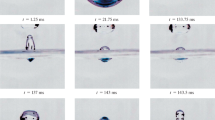Abstract—
For the first time, the evolution of the spreading pattern of a fallen water drop over the surface of a cavity and a crown in a deep layer of oil has been traced by high-resolution video and photography. At the stage of active drop submergence, the double layer formed by the contacting surfaces of immiscible fluids is the most rapid component of the flow. Droplets containing both fluids fly out from the tops of the spikes on the edge of the crown. The water covering the inner surface of the cavity and the crown flows unevenly downwards after submergence of the drop. Isolated anhydrous areas, voids, are formed on the surface of the crown and are separated by narrow bands of water, which eventually break up into separate drops. The bulk of the water unevenly submerges to the bottom of the cavity and, at its collapses, remains in the bulk of the liquid in the form of individual fragments, gradually tightening into smooth droplets. The regularities of the temporal changes in the splash height and in the shape of the cavity section are revealed.




Similar content being viewed by others
REFERENCES
A. M. Worthington and R. S. Cole, Philos. Trans. R. Soc. London 189 (1897). https://doi.org/10.1098/rsta.1897.0005
S. T. Thoroddsen, T. G. Etoh, and K. Takehara, Annu. Rev. Fluid Mech. 40, 257 (2008). https://doi.org/10.1146/annurev.fluid.40.111406.102215
L. V. Zhang, J. Toole, K. Fezzaa, and R. D. Deegan, J. Fluid Mech. 690, 5 (2012). https://doi.org/10.1017/jfm.2011.396
Yu. D. Chashechkin and V. E. Prokhorov, J. Exp. Theor. Phys. 122, 748 (2016). https://doi.org/10.1134/S1063776116020175
A. Prosperetti and H. N. Oguz, Annu. Rev. Fluid Mech. 25, 577 (1993). https://doi.org/10.1146/annurev.fl.25.010193.003045
Yu. D. Chashechkin and V. E. Prokhorov, Dokl. Phys. 58, 296 (2013). https://doi.org/10.1134/S1028335813070021
B. K. Sahay, Indian J. Phys. 18, 306 (1944).
D. W. Murphy, C. Li, V. d’Albignac, D. Morra, and J. Katz, J. Fluid Mech. 780, 536 (2015). https://doi.org/10.1017/jfm.2015.431
Yu. D. Chashechkin and A. Yu. Il’inyh, Problemy Evolyutsii Otkrytykh Sistem 19 (2), 60 (2016).
H. L’huissier, C. Sun, A. Prosperetti, and D. Lohse, Phys. Rev. Lett. 110, 264503 (2013). https://doi.org/10.1103/PhysRevLett.110.264503
F. Peters, M. Nüllig, and D. Miletic, Forsch. Ingenieurwes. 78, 87 (2014). https://doi.org/10.1007/s10010-014-0176-8
W. Wang, C. Ji, F. Lin, X. Wei, and J. Zou, Phys. Fluids 31, 037107 (2019). https://doi.org/10.1063/1.5089001
S. L. Manzello, J. C. Yang, and T. G. Cleary, Fire Saf. J. 38, 651 (2003). https://doi.org/10.1016/S0379-7112(03)00048-1
R. U. Meckenstock, F. von Netzer, C. Stumpp, T. Lueders, and A. M. Himmelberg, N. Hertkorn, Ph. Schmitt-Kopplin, M. Harir, R. Hosein, Sh. Haque, and D. Schulze-Makuch, Science 345, 673 (2014). https://doi.org/10.1126/science.1252215
T. Fujimatsu, H. Fujita, M. Hirota, and O. Okada, J. Colloid Interface Sci 264, 212 (2003). https://doi.org/10.1016/S0021-9797(03)00402-8
Hydrophysical complex of unique facilities for modeling hydrodynamic processes at the Ishlinsky Institute for Problems in Mechanics of the Russian Academy of Sciences. http://www.ipmnet.ru/uniqequip/gfk/. Cited February 6, 2020.
ACKNOWLEDGMENTS
These experiments were performed on the “Fine structural fast processes” facility, a part of the hydrophysical complex for modeling hydrodynamic processes at the Ishlinskii Institute for Problems in Mechanics, Russian Academy of Sciences.
Funding
This work was supported by the Russian Science Foundation, project no. 19-19-00598.
Author information
Authors and Affiliations
Corresponding authors
Additional information
Translated by E. Oborin
Rights and permissions
About this article
Cite this article
Chashechkin, Y.D., Ilinykh, A.Y. Spreading of a Water Drop in an Oil Layer. Dokl. Phys. 65, 75–81 (2020). https://doi.org/10.1134/S1028335820020020
Received:
Revised:
Accepted:
Published:
Issue Date:
DOI: https://doi.org/10.1134/S1028335820020020




